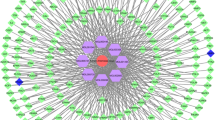Abstract
Background
Rosenroot (Rhodiola rosea) is a traditional Chinese herbal medicine. It has been used to treat patients with coronary artery disease (CAD). Salidroside is the main active constituent of rosenroot. This study was designed to explore the mechanism of salidroside in treating CAD and its role in angiogenesis in CAD systematically.
Methods
In this study, potential targets related to salidroside and CAD were obtained from public databases. Gene Ontology (GO), Kyoto Encyclopedia of Genes and Genomes (KEGG), Disease Ontology (DO) and CellMarker enrichment analyses were performed. The binding of salidroside to angiogenesis-related targets was assessed by PyMOL and Ligplot. Furthermore, the effects of salidroside on collateral circulation were evaluated by correlation analysis of these angiogenesis-related targets with the coronary flow index (CFI), and the influence of salidroside on human umbilical vein endothelial cell (HUVEC) proliferation and migration was assessed.
Results
Eighty-three targets intersected between targets of salidroside and CAD. GO and KEGG analyses indicated that salidroside mainly treated CAD through angiogenesis and anti-inflammatory action. There were 12 angiogenesis-related targets of salidroside in coronary heart disease, among which FGF1 (r = 0.237, P = 2.597E-3), KDR (r = 0.172, P = 3.007E-2) and HIF1A (r = -0.211, P = 7.437E-3) were correlated with the coronary flow index (CFI), and salidroside docked well with them. Finally, cell experiments confirmed that salidroside promoted the proliferation and migration of HUVECs.
Conclusions
This study revealed the potential molecular mechanism of salidroside on angiogenesis in CAD and provided new ideas for the clinical application of salidroside in the treatment of CAD.
Similar content being viewed by others
Background
Coronary artery disease (CAD), also known as coronary atherosclerotic heart disease, is a principal cause of cardiovascular death globally, and the mortality rates of CAD are increasing annually [1]. Percutaneous coronary intervention (PCI) and coronary artery bypass grafting (CABG) have greatly improved the symptoms and prognosis of CAD. However, certain patients cannot be treated surgically because of diffuse coronary artery disease [2]. Currently, effective angiogenesis and coronary collateral circulation are critical as they curtail cardiovascular events and ameliorate prognosis [3, 4].
Rosenroot (Rhodiola rosea) is a traditional Chinese herbal medicine and has significant medicinal and health benefits [5]. It has been extensively employed for numerous diseases, such as coronary artery diseases, hypertension, heart failure, heart arrhythmia and other cardiovascular diseases [6, 7]. Salidroside, one of the key active constituents of rosenroot, has been synthesized for clinical treatment and basic research. It plays an important role in the cardiovascular system due to its anti-hypoxia and antioxidant activities, antiaging activities, anti-inflammatory and antidiabetic activities [Full size image
Enrichment analysis of salidroside-related targets and targets for treatment of CAD
Through the Metascape online analysis tool, many GO terms and KEGG terms related to salidroside-related targets and targets for the treatment of CAD were enriched (Fig. 5), and the PPI network and key modules between the targets were obtained (Fig. 6). Interestingly, both salidroside-related targets and targets for the treatment of CAD were enriched in the biological processes of epithelial cell proliferation and morphogenesis of the epithelium. In addition to key module analysis results, there was still a high correlation with epithelial cell proliferation (Table 2). Further CellMarker enrichment and disease ontology analyses were performed by R (Fig. 5). The detailed results can be found in Supplementary Table 2. Notably, CellMarker enrichment analysis of the targets for the treatment of CAD revealed that these targets were enriched in blood vessels, bone marrow, muscle and other normal tissues. It was also enriched in endothelial cells and endothelial progenitor cells.
Salidroside and angiogenesis
Twenty-five gene sets related to angiogenesis were found in misgdb, containing a total of 463 genes (Supplementary Table 3). After intersecting the angiogenesis-related genes and the target of salidroside in the treatment of CAD, 12 genes remained, including VEGFA, KDR, CD34, FGF2, AKT1, FGF1, IL10, TEK, CCND2, IL32, HLA-C, and HIF1A. To further evaluate the binding affinity of these targets and salidroside, molecular docking analysis was conducted. However, the protein structures of CD34 and IL32 were not found in the Protein Data Bank, so they were excluded. The binding energies of salidroside and target proteins are shown in Table 3. The results showed that the docking energy of salidroside with the protein receptor ranged from -3.8 kcal/mol to -8.4 kcal/mol. These results suggested that salidroside docked well with these angiogenesis-related proteins under natural conditions. In particular, salidroside presented the lowest docking energy with AKT1 (docking energy: -8.4 kcal/mol). Furthermore, the correlation analysis showed that CFI was positively correlated with FGF1 (r = 0.237, P = 2.597E-3) and KDR (r = 0.172, P = 3.007E-2) but negatively correlated with HIF1A (r = -0.211, P = 7.437E-3). The detailed results are shown in Fig. 7. Finally, molecular docking results of salidroside with FGF1, KDR and HIF1A were visualized using pyMOL and Ligplot (Fig. 8). Salidroside mainly binds to the targets by forming multiple hydrogen bonds and hydrophobic interactions with the amino acid residues.
Molecular models of salidroside binding to angiogenesis-related proteins. A Docking mode and interactions between salidroside and FGF1, (B) salidroside and HIF1A, (C) salidroside and KDR. Salidroside is shown in green, red spoke arcs represent hydrophobic contacts, and the green dashed line represents hydrogen bonds
Salidroside promotes the proliferation and migration of HUVECs
To verify the effect of salidroside on HUVECs, CCK-8 and wound healing assays were performed. Our results indicated that 30 μM salidroside significantly increased the capacity to proliferate and migrate HUVECs compared with the control group (P < 0.01, Fig. 9). These results suggested that salidroside enhanced endothelial cell proliferation and migration and angiogenesis.
Salidroside promotes the proliferation and migration of HUVECs. A, B Wound healing assay was performed in HUVECs between different groups. C Proliferation activity of HUVECs was detected by cell counting Kit-8 (CCK8) assay. Error bars represented as the mean ± SD. ** indicated P < 0.01 versus control









